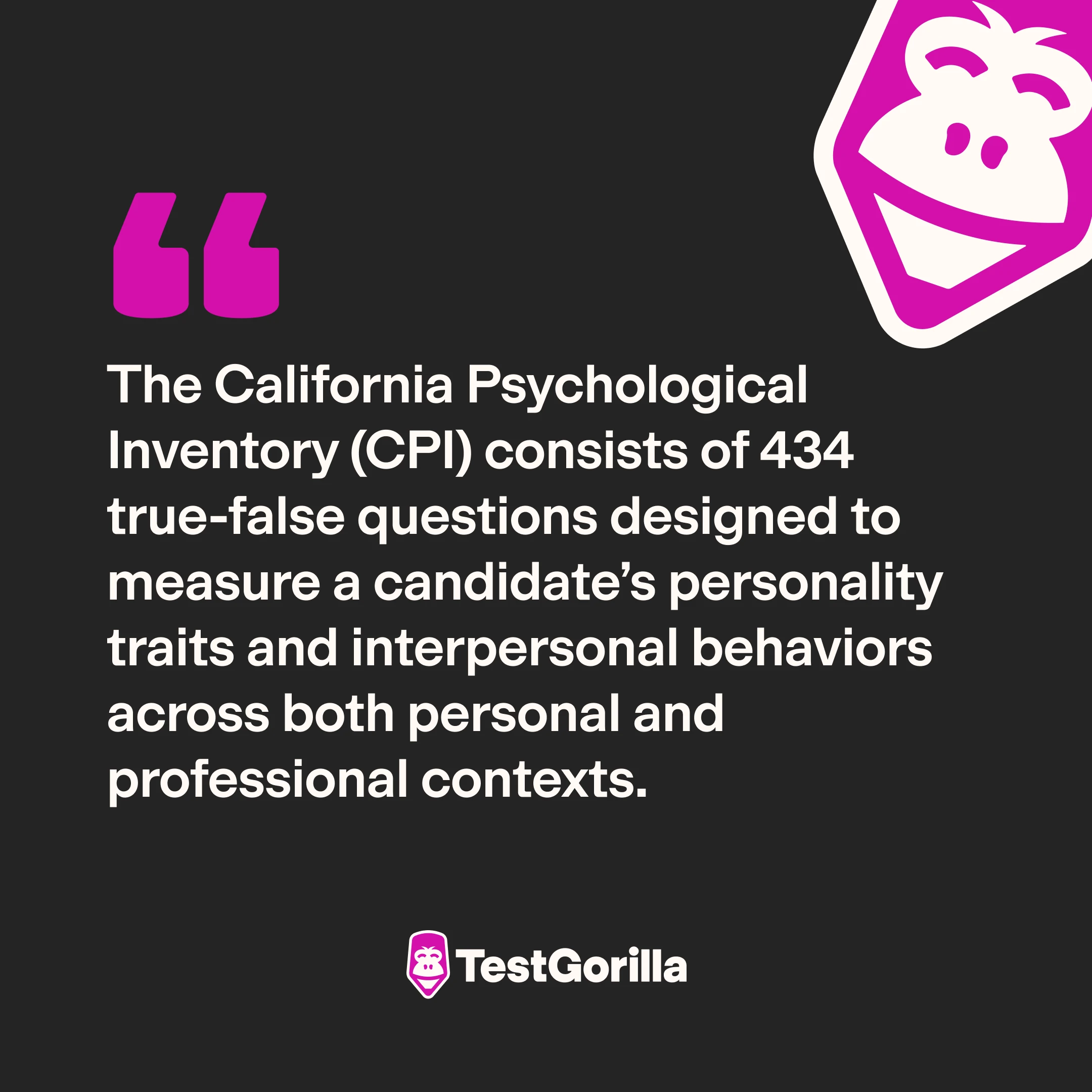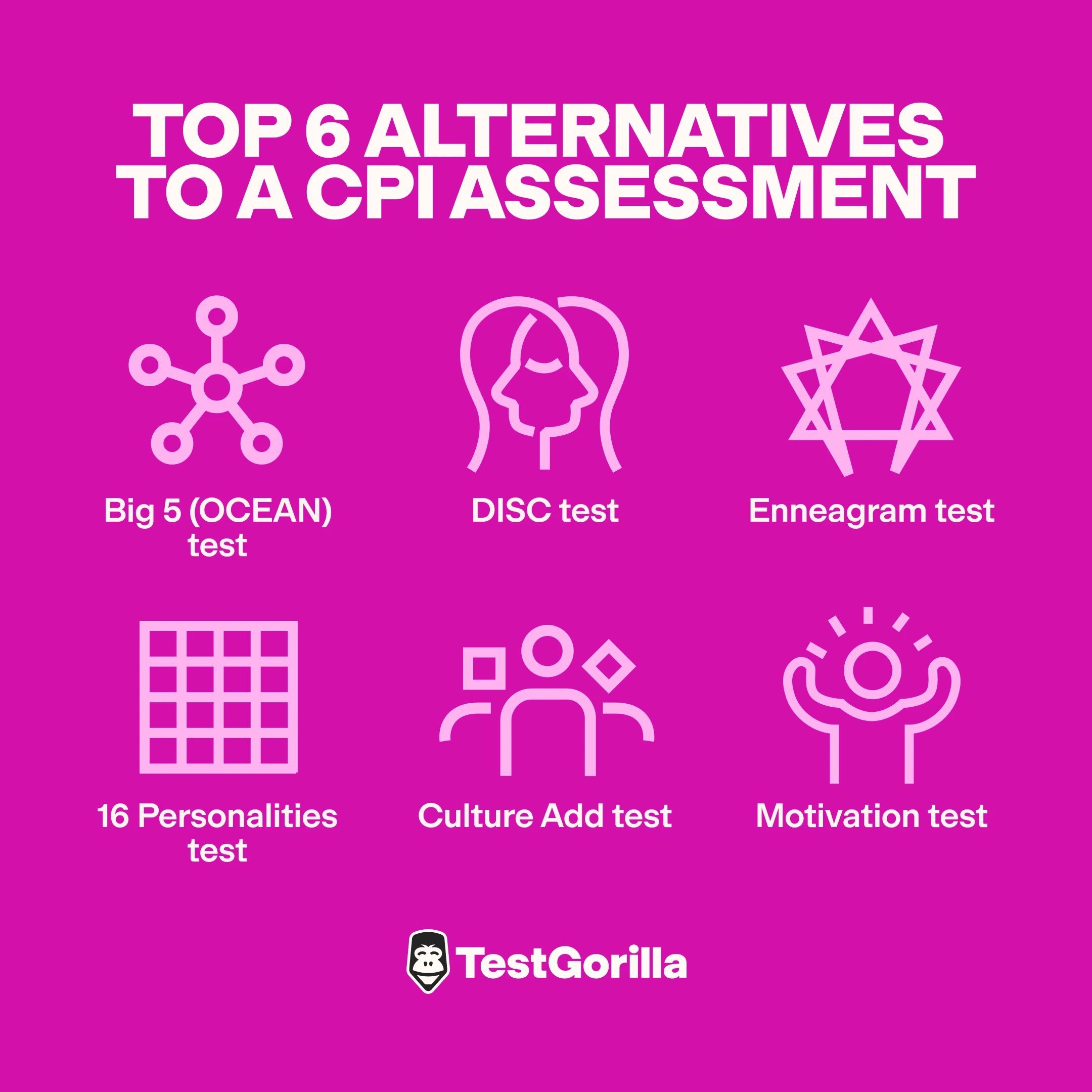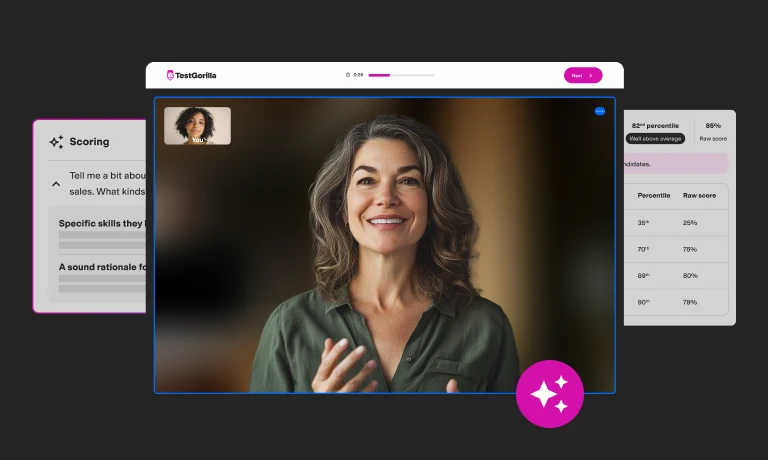The California Psychological Inventory (CPI) has been a staple personality assessment for hiring managers since its inception in 1956, but it's far from the only option. The field of personality testing has expanded significantly, offering a variety of tools that provide deep insights into candidates' motivations, work styles, and potential cultural impact.
With so many options available, choosing the right test(s) for your hiring needs can be challenging. This guide breaks down six powerful alternatives to the CPI, detailing how they work and when to use them. By the end, you'll be equipped to make better decisions about using personality testing in your hiring process, helping you build teams that truly excel.
Key takeaways
The Big 5 (OCEAN) test offers a comprehensive view of personality across five key dimensions, ideal for roles requiring emotional intelligence and adaptability.
DISC tests provide insights into communication styles and work preferences, making them valuable for team-building and leadership positions.
The Enneagram test reveals core motivations and growth areas, beneficial for personal development and conflict resolution within teams.
The 16 Personalities test offers nuanced insights into decision-making and information-processing styles, useful for matching candidates to specific role requirements.
Culture Add tests help identify candidates who will enhance your existing company culture, promoting diversity and innovation.
Motivation tests based on Oldham & Hackman's model assess what drives candidates, ensuring better job satisfaction and performance.
Understanding the CPI assessment
The California Psychological Inventory (CPI) consists of 434 true-false questions designed to measure a candidate’s personality traits and interpersonal behaviors across both personal and professional contexts. Due to its comprehensive nature, it can provide insights into aspects like leadership potential, stress tolerance, and even integrity.
However, the CPI's complexity is also a drawback. Its lengthy questionnaire and intricate scoring system make it time-consuming to administer and interpret. Specialized training is often required to analyze results effectively.
While the CPI remains a respected tool, the evolving needs of modern workplaces have led to the development of more focused, efficient alternatives. These newer tests often target specific aspects of personality or work behavior, providing quicker insights that are directly applicable to hiring decisions and team dynamics.
Each of the tests we'll discuss offers a unique approach to personality evaluation, often addressing specific needs or providing insights that the CPI might not capture as directly.
1. Big 5 (OCEAN) test
The Big 5 (OCEAN) test is a more modern approach to personality assessment compared to the CPI. Developed in the 1980s through statistical analysis of personality descriptors, it offers a streamlined alternative to the CPI's 434 items.
While the CPI provides detailed insights into specific traits, the Big 5 focuses on broad personality dimensions, making it quicker to administer and easier to interpret. This efficiency, combined with its strong empirical backing, has made the Big 5 increasingly popular in both academic research and practical applications like hiring.
How it works
The Big 5 test presents candidates with a series of statements, asking them to rate how accurately each one describes them on a scale from "strongly disagree" to "strongly agree." This self-assessment typically takes about 10-15 minutes to complete and evaluates candidates across five core personality dimensions:
Openness to experience
Conscientiousness
Extraversion
Agreeableness
Neuroticism (emotional stability)
What it tests for
These five traits provide a comprehensive snapshot of how a person thinks, feels, and behaves in various situations. Research by Andrew Neal et al. (2011) found that teams balanced for personality types using the Big 5 model showed much better outcomes on collaborative tasks, underscoring the value of using personality tests like the Big 5 in team formation and hiring decisions.
When to use it
The Big 5 can be beneficial when testing for roles that require strong emotional intelligence, adaptability, and teamwork. It's an excellent choice for managerial positions, customer-facing roles, and jobs that involve frequent collaboration or creative problem-solving.
⭐ To learn more: Take a look at our Big 5 (OCEAN) test page to add this test to your hiring assessment. We also offer guidance on interpreting Big 5 (OCEAN) results.
The best insights on HR and recruitment, delivered to your inbox.
Biweekly updates. No spam. Unsubscribe any time.
2. DISC test
Unlike the CPI, which evolved from clinical psychology, the DISC model has its roots in workplace behavior theory. Developed by William Moulton Marston in the 1920s, it predates the CPI by several decades.
While the CPI aims to provide a comprehensive personality profile, DISC focuses specifically on behavioral styles in work environments. This targeted approach makes DISC particularly attractive if you want to quickly understand how a candidate might interact with colleagues and handle workplace challenges, without going into the deeper psychological aspects that the CPI explores.
Research by Ioanna Lykourentzou et al (2016) found that by using a DISC test, teams could be balanced by personality types, leading to better outcomes for crowd teams.
How it works
The DISC assessment presents candidates with a series of statements or adjectives, asking them to choose which ones best describe their behavior in various situations. The test typically takes about 10-15 minutes to complete and evaluates candidates across four primary behavioral dimensions:
Dominance
Influence
Steadiness
Conscientiousness
What it tests for
These dimensions provide insights into a person's communication style, work preferences, and manner of interacting with others.
When to use it
DISC is particularly useful for roles that involve teamwork, leadership, or customer interaction. These include sales positions, managerial roles, and jobs that require strong interpersonal skills or conflict resolution abilities.
⭐ To learn more: Visit our DISC test page to add this assessment to your hiring process. For a comprehensive understanding of personality tests, including DISC, explore our guide to personality tests.
3. Enneagram test
The Enneagram stands apart from the CPI and other personality tests due to its spiritual and philosophical origins. Developed in the mid-20th century by Oscar Ichazo and Claudio Naranjo, it incorporates elements from various mystical traditions.
While the CPI is rooted in empirical psychology, the Enneagram offers a more holistic view of personality, focusing on core motivations and potential for personal growth. This unique perspective can provide insights that more traditional assessments might miss, making it an intriguing complement or alternative to tests like the CPI.
The test’s origins might raise an eyebrow in regards to its effectiveness, but research by Wagner and Walker (1983) found that the Enneagram test demonstrated satisfactory reliability and validity, providing a consistent and accurate measure of behavioral styles.
How it works
The Enneagram test presents candidates with a series of statements or questions, asking them to rate how well each one describes them. The assessment typically takes about 30-40 minutes to complete, making it slightly longer than some other personality tests. It identifies nine distinct personality types, each with its own core motivations, fears, and growth areas:
What it tests for
The Enneagram provides insights into a person's deepest motivations, how they view the world, and their potential areas for personal and professional growth. This focus on core motivations and growth areas makes it a unique complement to other personality tests.
When to use it
The Enneagram is best for roles that require strong self-awareness, emotional intelligence, and interpersonal skills. You might consider using it for leadership positions, roles in human resources or counseling, and jobs that involve mentoring or coaching others.
⭐ To learn more: Explore our Enneagram Personality test page to add this assessment to your hiring process. We also offer insights on using an Enneagram test in hiring and interpreting Enneagram test results on our blog.
4. 16 Personalities test
Unlike the CPI's focus on predicting behavior, the 16 Personalities test aims to describe how individuals perceive the world and make decisions. This can provide unique insights into team dynamics and individual work styles.
How it works
Based on Carl Jung's theory of psychological types, the 16 Personalities test presents candidates with a series of questions or statements, asking them to indicate their level of agreement on a scale. This assessment typically takes about 15-20 minutes to complete and evaluates candidates across four dichotomies:
Extraversion vs. Introversion
Sensing vs. Intuition
Thinking vs. Feeling
Judging vs. Perceiving
What it tests for
These combinations result in 16 distinct personality types, each with its own characteristics, strengths, and potential areas for growth. The test provides insights into how individuals process information, make decisions, and interact with their environment.
When to use it
The 16 Personalities test is particularly useful for roles that require a specific balance of traits or for building diverse teams with complementary strengths. It's a strong choice for a wide range of positions, from technical roles to creative ones.
⭐ To learn more: Visit our 16 Personalities test page to add this assessment to your hiring process. We can also offer you a deeper understanding of what the 16 Personalities test reveals and its accuracy in hiring.
5. Culture Add test
The Culture Add test represents a significant shift from traditional personality assessments like the CPI. While the CPI and similar tests focus on individual traits, the Culture Add test examines how an individual's values and behaviors align with and potentially enhance an organization's culture.
This test emerged in response to criticisms of "culture fit" assessments, which could lead to homogeneous workplaces. By focusing on how candidates can add to a culture rather than just fit into it, this test offers a modern approach to building diverse, innovative teams – an aspect not directly addressed by the CPI.
How it works
The Culture Add test typically presents candidates with scenarios or statements related to workplace values, attitudes, and behaviors. Candidates are asked to rate their agreement or likelihood of certain actions. This assessment usually takes about 15-20 minutes to complete.
What it tests for
Unlike traditional "culture fit" assessments, the Culture Add test evaluates how a candidate's unique perspectives, experiences, and values could enhance and diversify your existing company culture. It measures alignment with core company values while also identifying areas where a candidate could bring fresh ideas and approaches.
When to use it
The Culture Add test is perfect when you're looking to build diverse, innovative teams or when your company is undergoing cultural transformation. It works for roles where you want to ensure that new hires will both thrive in and positively impact your organizational culture.
⭐ To learn more: You can use our Culture Add test page to add this assessment to your hiring process. For insights on why Culture Add is the new way forward and how to leverage this talent acquisition strategy, our blog offers further valuable resources.
6. Motivation test (Oldham & Hackman's Job Characteristics)
The Motivation test based on Oldham & Hackman's Job Characteristics Model offers a distinct approach compared to general personality assessments like the CPI. Developed in the 1970s, it focuses on how job design affects employee motivation and satisfaction.
Compared to the CPI’s broad focus on personality traits, the Motivation test hones in on work-related factors that drive engagement and performance. This can be particularly valuable if you’re looking to improve job design, increase employee satisfaction, and reduce turnover.
How it works
This test presents candidates with questions or scenarios related to different aspects of job satisfaction and motivation. Candidates typically rate their preferences or likely responses. The assessment usually takes about 15-20 minutes to complete.
What it tests for
This test evaluates a candidate's motivation across five core job characteristics:
Skill Variety
Task Identity
Task Significance
Autonomy
Feedback
It helps identify what drives a candidate and what type of work environment they're likely to find most motivating and satisfying.
When to use it
The Motivation test can help when hiring for roles where high motivation and job satisfaction are important, such as leadership positions, roles with high autonomy, or jobs requiring long-term commitment and engagement.
⭐ To learn more: Visit our Motivation test page to add this assessment to your hiring process. You can also take a look at our insights on measuring candidates' job motivation and the role of motivation in skills-based hiring.
Accurately assessing candidates’ personalities with TestGorilla
These six alternatives to the CPI assessment offer unique insights into candidate personalities and potential.
But the real power lies in combining them with skills-based assessments. TestGorilla's platform offers a suite of over 350+ tests, including all the personality assessments we've discussed, alongside role-specific skills tests. This multi-measure approach provides a 360-degree view of each candidate, leading to better hires, more diverse teams, and a stronger organization.
Ready to transform your recruitment strategy? Take a product tour to see TestGorilla in action. If you're ready to start, sign up for our free plan and build your first assessment today. For personalized guidance, book a demo with our team.
FAQs
What is the CPI assessment?
The California Psychological Inventory (CPI) is a comprehensive personality assessment that measures interpersonal behavior, values, and motivations. It's designed to predict an individual's behavior in personal and work-related situations.
What are the four categories of the CPI assessment?
The CPI assessment is divided into four broad categories: interpersonal orientation, normative orientation, self-management, and cognitive orientation.
Is the CPI assessment a personality test?
Yes, the CPI is a personality test. It's a multi-dimensional inventory that assesses various aspects of personality, including interpersonal style, social and emotional adjustment, and approach to tasks and challenges in both personal and professional contexts.
You've scrolled this far
Why not try TestGorilla for free, and see what happens when you put skills first.




















